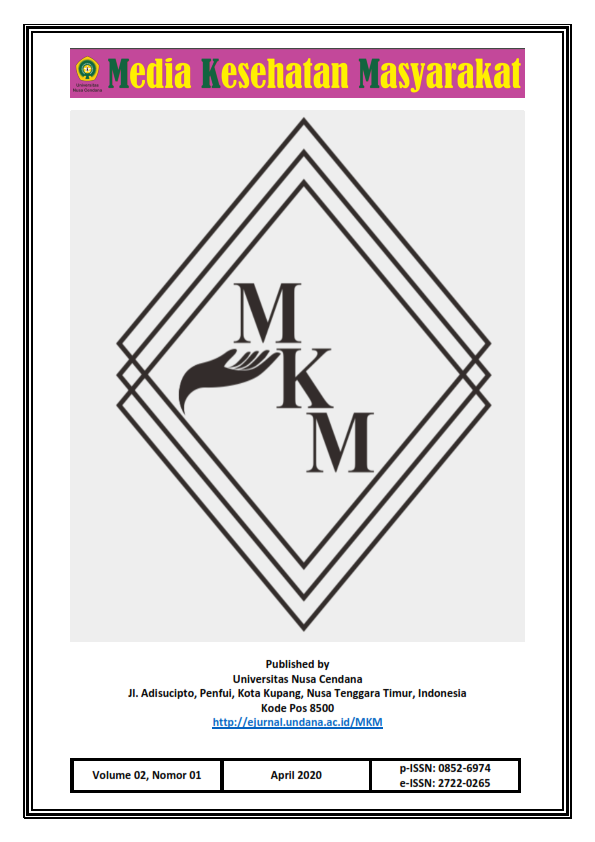Pengaruh Intervensi Makanan Tambahan Padat Energi dan Protein Berbasis Pangan Lokal terhadap Perbaikan Status Gizi Balita
Abstract
Malnutrition problems that mostly occur in NTT are particularly caused by low protein intake. Therefore, this study was designed to intervene in feeding energy and protein dense snack to improve the nutritional status of children under five. This research was conducted in Tanah Putih Village, Kupang Tengah Sub-district, Kupang District. The research was an experimental method with a completely randomized design. Three types of intervention were given, namely: p1 = cassava + skipjack fish; p2 = cassava + rice beans; and p3 = cassava + skipjack fish + rice beans. Each sample consumed energy and protein dense snacks (according to treatment) for 30 days of trial. The results showed that the majority of children had a higher acceptance level for the intervention (88,9%). The results also showed that the provision of energy-dense food and protein significantly (p <0.05) improved the nutritional status of children under five, with weight for height indicator. However, the intervention had no significant effect (p> 0.05) with the indicator of height for age. The results of the analysis of variance showed a significant nutritional status improvement for the composition of cassava and fish (P1) (p <0.05) using the indicators wight for height and weight for age. Yet, it had not significantly contributed to improving the nutritional status of children under five using the height for age indicator.Advanced analysis using the Duncan test showed that the intervention treatment with the composition of cassava and rice beans had the strongest effect on improving the nutritional status of children under five.
Downloads
References
Hariwibowo AS, Handayani W. Asuhan Keperawatan Pada Klien dengan Gangguan Sistem Hematologi. Salemba Medika. Jakarta: Salemba Medika; 2008.
Winarno FG. Teknologi Pengolahan Rumput Laut. Pustaka Sinar Harapan; 1990.
Suhaimi A. Pangan, Gizi, dan Kesehatan. Deepublish. Yogyakarta: Deepublish; 2019.
Badan Penelitian dan Pengembangan Kesehatan. Hasil Riskesdas 2013 [Internet]. Kementerian Kesehatan Republik Indonesia. Jakarta; 2013. Available from: https://www.kemkes.go.id/resources/download/general/Hasil Riskesdas 2013.pdf
Sediaoetama AD. Ilmu Gizi untuk Mahasiswa dan Profesi Jilid I. Dian Rakyat. Jakarta: Dian Rakyat; 2010.
Oematan G, Aspatria U. Faktor-Faktor Penentu Kejadian Gizi Buruk Stunting di Daerah dengan Karakteristik Pertanian Lahan Kering Kabupaten Kupang, Provinsi Nusa Tenggara Timur. J Pangan, Gizi, dan Kesehat. 2013;5(1):725–36.
Mudita IW, Aspatria U, Surayasa MT. Pengembangan Model Pengelolaan Ketahanan Hayati Penyimpanan Jagung Berbasis Masyarakat untuk Meningkatkan Ketahanan Pangan di Wilayah Beriklim Kering. Lembaga Penelitian, Universitas Nusa Cendana. Kota Kupang; 2009.
Steel RGD, Torrie JH. Principles and Procedures of Statistics. McGraw-Hill Book Company, Inc., New York, Toronto, London; 1960.
Hardinsyah M, Supariasa IDN. Ilmu Gizi: Teori dan Aplikasi. Buku Kedokteran EGC. Jakarta: Buku Kedokteran EGC; 2016.
Supariasa IDN, Bakri B, Fajar I. Penilaian Status Gizi Edisi Revisi. Jakarta: Buku Kedokteran EGC; 2012.
Almatsier S, Soetardjo S, Soekatri M. Gizi Seimbang Dalam Daur Kehidupan. Jakarta: Gramedia Pustaka Utama; 2017.
Gibson RS. Principles of Nutritional Assessment. 2nd ed. New York: Oxford university press, USA; 2005.
Copyright (c) 2020 Author

This work is licensed under a Creative Commons Attribution-ShareAlike 4.0 International License.

 Utma Aspatria(1*)
Utma Aspatria(1*)














